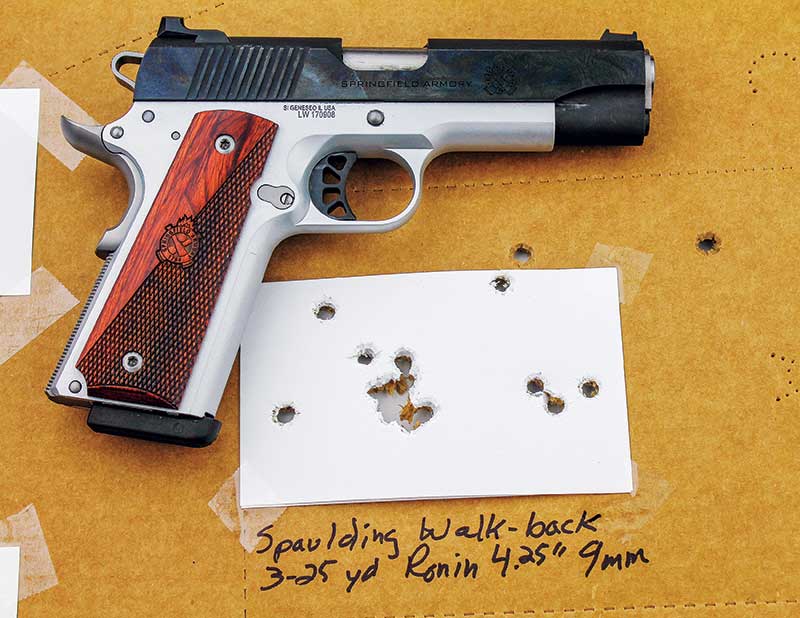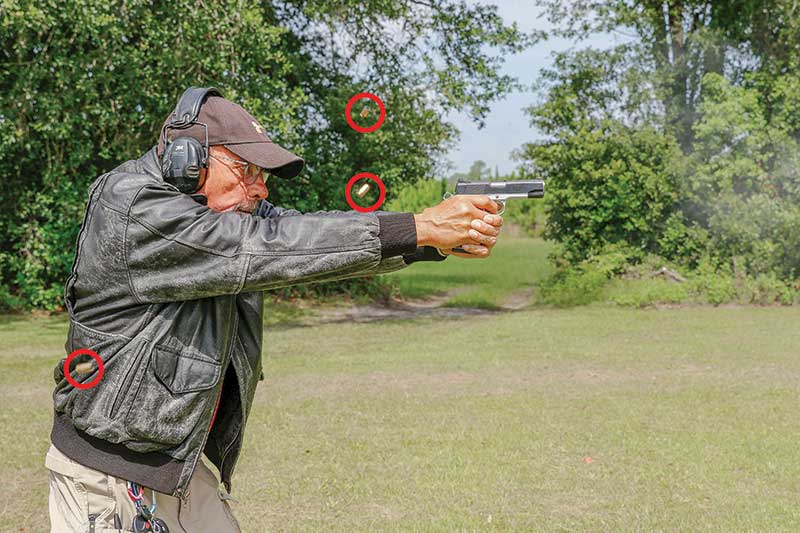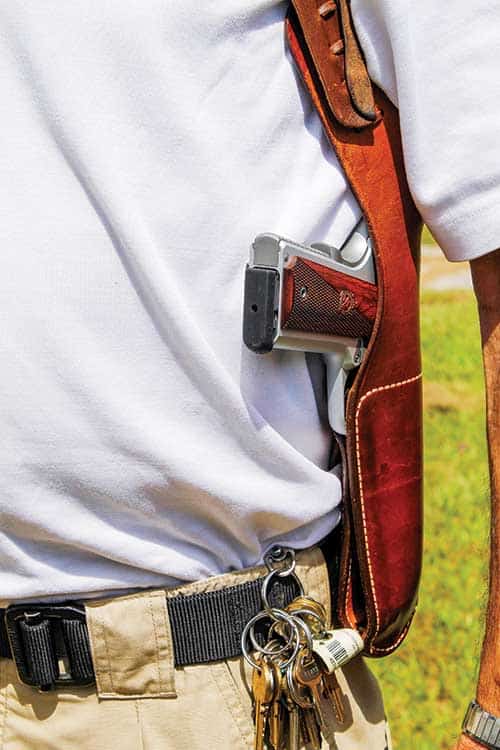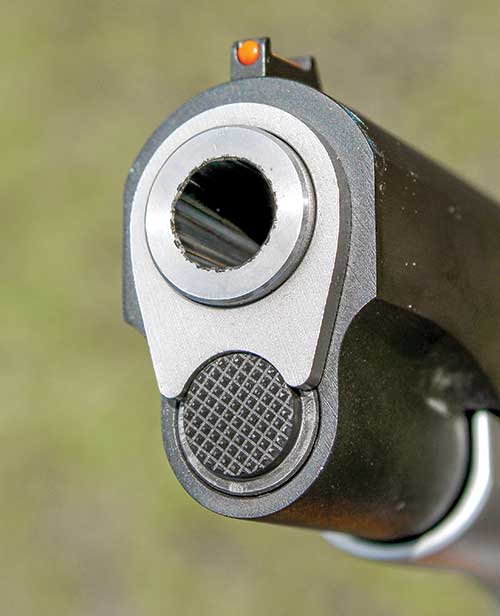Springfield Armory 9mm Ronin 1911
70-year-old concept for the 21st Century
Take the 9mm lightweight Colt Commander of 1950, update it, make it work with a cartridge shorter in overall length (OAL) than it was originally designed to cycle and feed. Give it slim grips to fit more hands better, replace the horrid little hand-biting stub of a grip safety plaguing the first generation of Commanders. Build it so you can retail for $150 below the thousand-dollar mark. Et voila! — You have the 4.25″ Ronin Operator 9mm from Springfield Armory.
Unboxing
The test sample, serial number LW 170908, came with a two-tone finish popularized by Jeff Cooper, the man who really led the mid-20th Century renaissance of the 1911 pistol. The aluminum frame is a satiny silver, the top-end a pleasing blue steel. No forward slide grooves and no unnecessary full-length recoil spring guide, to which this traditionalist can only say “Yay for both.”
It came with three nine-round magazines with bumper pads and a spacer in the back of the magazine cavity that compensates for the 9mm cartridge’s short OAL while still keeping the bullet nose close to the feed ramp. Only one of those nine-rounders was used in testing — I went with 10-round Wilson Combat mags for the rest of the shooting. Since the butt of the gun is going to be lengthened by a pad anyway, I want another cartridge out of the deal. The magazine well was slightly beveled for smoother reloading.
Sights were fixed — two big white dots straddling a wide rear notch, and a red fiber optic rod in the front post. The rear sight has a ledge to allow one-handed “wounded defender” slide cycling against belt or holster. The trigger is medium length but easy to reach thanks to the slim wooden grip panels that seem to be a standard feature on all the Ronin models. Pioneered by shooting champ and pistolsmith J. Michael Plaxco back in the ’80s for IPSC/IDPA pioneer John Sayles and his wife Sally, these slim grips feel “different,” but I like how they let you get “more hand around the gun” and “more finger on the trigger.” By the way, trigger pull weight averaged 4.49 lbs. — “good to go” for street carry with its liability concerns, but no impediment to good shooting.
Accuracy
I ran the lightweight Ronin at 25 yards from a Caldwell Matrix rest on a concrete bench. Each five-shot group was measured overall and again for the best three hits, because the latter has been shown to roughly equal what the same gun and load will do from a machine rest at the same distance. A time-saver for the tester, obviously, but more importantly, something easier for the reader to comparison-test with their own samples of the same firearm and ammo. The protocol tends to factor out unnoticed human error.
Testing encompassed the three most popular bullet weights for the caliber. Everything was well under the popular formula of “4″ at 25 yards equals adequate service pistol accuracy.” The 147-grain Winchester FMJ delivered 3.45″ for all five and 1.05″ for “best three.” SIG 124-grain V-Crown jacketed hollow point was a 10th of an inch tighter overall, five hits 3.35″ apart with the same 1.05″ best three cluster. Black Hills 115-grain JHP at +P velocity shot tightest of all: 2.15″ for all five and 1.35″ for the three closest. A “best three” average of 1.15″ tells me this is, mechanically, a “sub-two-inch” gun for grouping capability, and, for a 4.25″ barrel 9mm 1911, folks, “Dat’s sumpin!”
If grouping is one side of accuracy, the flip side is POA/POI: point of aim vis-à-vis point of impact. For this tester the gun shot center for windage but high with 124-grain at 25 yards, high and right for some reason with the 115-grain +P, but spot on with the 147-grain.
Since shot placement is the first imperative for “stopping power,” when I did the “carry” part of the test it was loaded with Federal HST 147-grain, which seems to be unexcelled in street performance with a “heavy for caliber” bullet weight. I was suffering some lumbar spine issues at test time so this retro-lookin’ gun went into a retro kind of shoulder holster, the classic Bianchi X15. The light weight of the aluminum-framed 1911 was something I learned to appreciate in a lifetime of carrying 1911 pistols and it held true with the Springfield Ronin aluminum-frame 9mm.
Stress Test
I like to test a gun’s handling under pressure, either in a match or demonstrating to a class of paying customers, but neither was possible in this case. Pandemic closures had cut down both classes and tournaments. With the meteorologists forecasting an oncoming hurricane where I was, we accelerated the testing, shooting the hell out of the Ronin in just a few days. The best I could do for stress was to shoot a drill, promising myself it would be like a live performance — one chance only to do it right. I chose the Dave Spaulding Fade-Back drill Tom Givens had shared with me. Three shots per run, at 3/5/7/10/15/25 yards each — on a 3×5 card.
The feathery 9mm gave me good hits til 25 yards, where I pulled one out so close a .45 slug would probably have cut the edge — I could almost hear Jeff Cooper saying “I told you to use a .45!” — and on the last shot, I honked the bullet high left. The result was 16 out of 18 on the card, which rounds up to 89%. I can assure you the two bad hits were my fault, not the pistol
Rationale
Why buy this gun? Recoil is ridiculously mild. It ran 100% with zero malfunctions in the hands of testers male and female ranging from barely five-feet tall to six-feet plus, and everyone who shot it really liked it. The best 9mm rounds have exceeded the old .45 hardball in terms of fight-stopping damage inflicted and have gotten better still in recent years. The timeless ergonomics of the 1911 design are still in play.
The Ronin Operator comes from the same Springfield Armory that gave us the little scaled-down 9mm EMP (Enhanced Micro Pistol) that has gladdened handgunners’ hearts for 15 years. It carries the same 9+1 rounds of the same ammo and can now be had in a 4″-barrel version with 10+1 of the same stuff. I am fond of the EMP because it fits my hand superbly, comes with ambi-safety (the Ronin doesn’t) and is as reliable and accurate as I can ask for. So why buy the Ronin instead?
Glad you asked. The Ronin’s MSRP is $849 while the EMP starts in the low $1,100 range. Made on specialized machinery, EMPs are naturally more expensive. EMPs have proprietary magazines and parts, including grips; the Ronin can accept lots of aftermarket 1911 9mm mags and generic 1911 stocks and other parts.
Choices are good.
So is the Springfield Armory Ronin 4.25″ lightweight 9mm. It’s also available in .45 ACP; look for a test article in our sister publication, American Handgunner.









